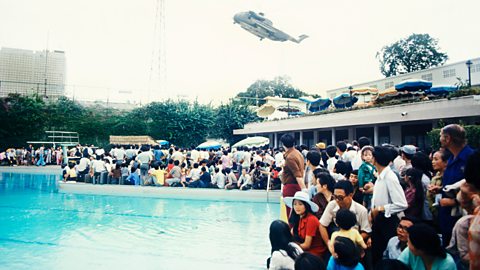US involvement in Vietnam, 1970 - 1973
Operation Menu
- President Richard Nixon wanted to improve the negotiating position of the USA in the peace talks, so his team planned Operation Menu.
- The plan was to expand the war into Cambodia and bomb communistA supporter of a classless society where all property is publicly owned. bases from the air.
- The operation began in March 1969.
- It was kept secret from the US public, as Nixon feared their reaction would be negative.
- It was only discovered in May 1970, when the New York Times exposed it. By that time, the operation was over and the USA was involved in an invasion of Cambodia.
Expansion into Laos
- In January 1971, forces of the Army of the Republic of Vietnam (ARVN) led an invasion, supported by US troops, of Laos.
- The plan was similar to the plan for the Cambodian invasion. The troops were to destroy communist bases and communist supply lines into South Vietnam.
- This operation was called Operation Lam Son 719, but it failed as the ARVN forces were defeated and suffered many casualties.
The Easter Offensive
- The North Vietnamese responded to the expansion of the war with the Easter Offensive.
- The plan was to attack the ARVN using the North Vietnamese Army (NVA) and the Viet Cong.
- In March 1972, communist troops led by General Giap launched an attack on South Vietnam from the North, Cambodia and Laos.
- During the offensive, which lasted until October 1972, it is estimated that over 100,000 soldiers supporting the North were killed.
- Although the communists took some territory, the main achievement of the offensive was to show that Vietnamisation was unlikely to work in the long term, as the ARVN relied heavily on US support.
Operation Linebacker
- One of the reasons the Easter Offensive failed was Operation Linebacker.
- In May 1972, the US started large-scale bombing raids on North Vietnam and the communist troops in the South.
- Forces also cut off supplies by blockading To block access to a country in order to prevent supplies or people from reaching it. the North and mining one of its key harbours.
- This approach was highly effective and led to progress in the peace talks.
Peace and the failure of Vietnamisation
The Vietnam War had become so unpopular in the USA that the government was determined that peace talks would result in agreement. In January 1973, representatives of the USA, North Vietnam, South Vietnam and the Viet Cong signed a peace agreement in Paris. It was agreed that:
- The USA would withdraw all of its troops.
- North Vietnam and South Vietnam would respect a dividing line at the 17th parallelThe line of latitude that ran roughly along the border between North and South Vietnam, until the reunification of Vietnam in 1976. and work together to reunite the two countries through peaceful means.
However, the peace terms were not honoured. Forces from the North later invaded South Vietnam. On 30 April 1975, the last few Americans still in South Vietnam were airlifted out of the country as Saigon (now known as Ho Chi Minh City) came under the control of communist forces. South Vietnam surrendered later that day.
The Vietnam War had cost 58,000 American lives. As many as 2 million Vietnamese soldiers and civilians were killed. By the end of 1975, Vietnam, Cambodia and Laos were all controlled by communist leaders.
